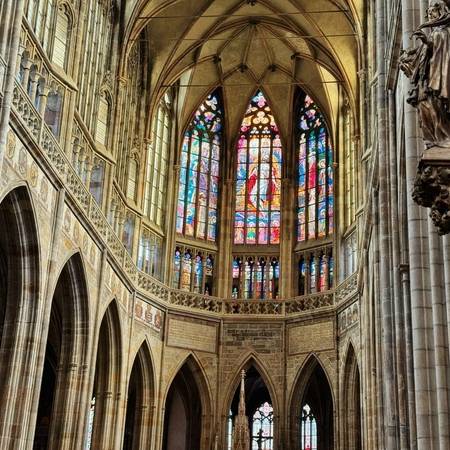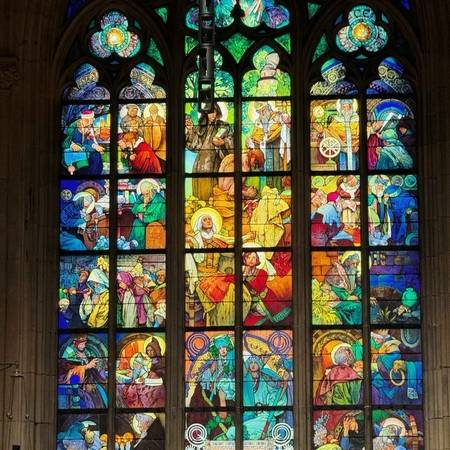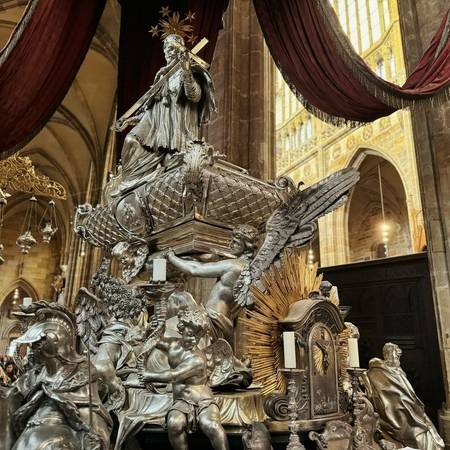The cathedral exudes a sense of history from the moment you enter. Massive columns support the vaulted ceilings, which are framed by magnificently painted stained glass windows that reflect and play with the light. As you have previously seen, the most significant part of the cathedral is the Chapel of St. Vaclav, which houses valuable Czech coronation insignia and holy relics, as well as many royal tombstones and Czech crown jewels, behind seven locks. The chapel is not open to tourists.
In the most beautiful side chapel of St. Vaclav, there is a sarcophagus of St. Vaclav made of plaster mixed with gold. St. Vaclav the Martyr (904-930), commemorated on 28 September, was a Czech duke and the Duke of Bohemia. He was wisely brought up by his grandmother, St Ludmila. Despite being strict to himself, Vaclav ruled his kingdom peacefully and was merciful to the poor. He rescued pagan captives who had been sold in Prague and made sure they were baptised. On arriving at his brother Boleslav's, Vaclav immediately expressed his desire to visit the church, and as he opened the church door, an assassin sent by his brother killed Vaclav.
The cathedral also houses the tombs of saints, the kings and dukes, and archbishops, the most renowned being those of St. John of Nepomuk and Charles IV. One coffin contains Charles IV, while the other houses all of his wives: Blanche of Valois, Ona of Bavaria, Ona of Schwydnitz, and Elisabeth of Pomerania.
St. John Nepomuk was a canon law doctor who worked for the archbishop of Prague. Nepomuk was killed for defending the archbishop's authority over King Vaclav IV. One of the cherubs gestures toward the saint's tongue, which is said to never decay. St. Nepomuk was buried in a 1.5-tonne silver sarcophagus, with a crystal coffin inside.
Behind the seven locked doors the greatest treasure of the Czech state, the 14th century crown of Charles IV (he was crowned 5 times in total) is kept. The crown is incrusted with the largest ruby in the world. The keys are held by 7 important Czechs who can unlock the doors by taking turns to enter.
Inside the cathedral is the magnificent royal balcony of Vladislav Jagiellonian, accessible to the royal family from the palace bedrooms.
The canopy was given by Maria Theresa (1717-1780), Empress of the Holy Roman Empire's Habsburg dynasty, Queen Regent of Bohemia and Hungary, and Princess of Austria, who gave birth to 16 children. Maria Theresa ascended to the imperial throne in 1745, following the death of Emperor Charles VII, who also claimed the Austrian succession. Her husband, Francis I, was crowned emperor. Maria Theresa, a Catholic and opponent of religious freedom, only visited Prague twice.
Rudolf II, the eldest son of Holy Roman Emperor Maximilian II and Maria of Spain (daughter of Charles V and Isabella of Portugal), was the only king to live in Prague. He settled in Prague in 1583, where he established the Kunstkammer, which was very important for the advancement of science in 17th-century Europe. Rudolf II reversed his policy of religious tolerance, restricting Protestant rights and renewing war with the Ottoman Empire.
Rudolph II spent the rest of his life under the tight observation of his subordinates, in solitude and primarily at home, refusing to travel or even participate in state activities. He was more interested in the esoteric sciences, particularly astrology and alchemy, which were fashionable throughout the Renaissance, as well as a variety of personal interests, including horseback riding, watchmaking, collecting, and patronage. Rudolf experienced recurrent spells of melancholy (depression), which was common among the Habsburgs. Rudolph II died in Prague on January 12, 1612, at the age of 59.
At the end of the 16th century, a white marble royal mausoleum was designed in Vienna to bury Anna Jagiellonian, her husband Ferdinand I, and their son Maximilian II. Anna Jagiellonian and Ferdinand I were deeply in love, which was unusual in Europe, and the queen bore 15 children.






Reviews